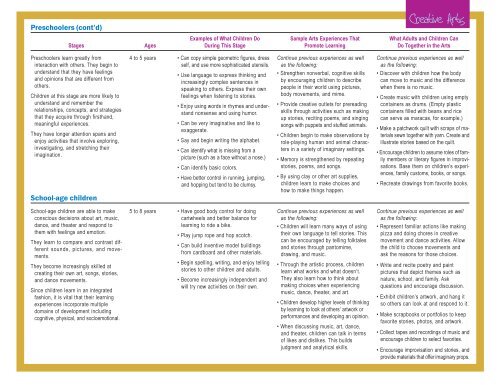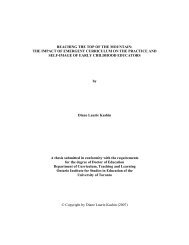Creative Arts
You also want an ePaper? Increase the reach of your titles
YUMPU automatically turns print PDFs into web optimized ePapers that Google loves.
Preschoolers (cont’d)<br />
<strong>Creative</strong> <strong>Arts</strong><br />
Stages<br />
Ages<br />
Examples of What Children Do<br />
During This Stage<br />
Sample <strong>Arts</strong> Experiences That<br />
Promote Learning<br />
What Adults and Children Can<br />
Do Together in the <strong>Arts</strong><br />
Preschoolers learn greatly from<br />
interaction with others. They begin to<br />
understand that they have feelings<br />
and opinions that are different from<br />
others.<br />
Children at this stage are more likely to<br />
understand and remember the<br />
relationships, concepts, and strategies<br />
that they acquire through firsthand,<br />
meaningful experiences.<br />
They have longer attention spans and<br />
enjoy activities that involve exploring,<br />
investigating, and stretching their<br />
imagination.<br />
School-age children<br />
4 to 5 years<br />
• Can copy simple geometric figures, dress<br />
self, and use more sophisticated utensils.<br />
• Use language to express thinking and<br />
increasingly complex sentences in<br />
speaking to others. Express their own<br />
feelings when listening to stories.<br />
• Enjoy using words in rhymes and understand<br />
nonsense and using humor.<br />
• Can be very imaginative and like to<br />
exaggerate.<br />
• Say and begin writing the alphabet.<br />
• Can identify what is missing from a<br />
picture (such as a face without a nose.)<br />
• Can identify basic colors.<br />
• Have better control in running, jumping,<br />
and hopping but tend to be clumsy.<br />
Continue previous experiences as well<br />
as the following:<br />
• Strengthen nonverbal, cognitive skills<br />
by encouraging children to describe<br />
people in their world using pictures,<br />
body movements, and mime.<br />
• Provide creative outlets for prereading<br />
skills through activities such as making<br />
up stories, reciting poems, and singing<br />
songs with puppets and stuffed animals.<br />
• Children begin to make observations by<br />
role-playing human and animal characters<br />
in a variety of imaginary settings.<br />
• Memory is strengthened by repeating<br />
stories, poems, and songs.<br />
• By using clay or other art supplies,<br />
children learn to make choices and<br />
how to make things happen.<br />
Continue previous experiences as well<br />
as the following:<br />
• Discover with children how the body<br />
can move to music and the difference<br />
when there is no music.<br />
• Create music with children using empty<br />
containers as drums. (Empty plastic<br />
containers filled with beans and rice<br />
can serve as maracas, for example.)<br />
• Make a patchwork quilt with scraps of materials<br />
sewn together with yarn. Create and<br />
illustrate stories based on the quilt.<br />
• Encourage children to assume roles of family<br />
members or literary figures in improvisations.<br />
Base them on children’s experiences,<br />
family customs, books, or songs.<br />
• Recreate drawings from favorite books.<br />
School-age children are able to make<br />
conscious decisions about art, music,<br />
dance, and theater and respond to<br />
them with feelings and emotion.<br />
They learn to compare and contrast different<br />
sounds, pictures, and movements.<br />
They become increasingly skilled at<br />
creating their own art, songs, stories,<br />
and dance movements.<br />
Since children learn in an integrated<br />
fashion, it is vital that their learning<br />
experiences incorporate multiple<br />
domains of development including<br />
cognitive, physical, and socioemotional.<br />
5 to 8 years • Have good body control for doing<br />
cartwheels and better balance for<br />
learning to ride a bike.<br />
• Play jump rope and hop scotch.<br />
• Can build inventive model buildings<br />
from cardboard and other materials.<br />
• Begin spelling, writing, and enjoy telling<br />
stories to other children and adults.<br />
• Become increasingly independent and<br />
will try new activities on their own.<br />
Continue previous experiences as well<br />
as the following:<br />
• Children will learn many ways of using<br />
their own language to tell stories. This<br />
can be encouraged by telling folktales<br />
and stories through pantomime,<br />
drawing, and music.<br />
• Through the artistic process, children<br />
learn what works and what doesn’t.<br />
They also learn how to think about<br />
making choices when experiencing<br />
music, dance, theater, and art.<br />
• Children develop higher levels of thinking<br />
by learning to look at others’ artwork or<br />
performances and developing an opinion.<br />
• When discussing music, art, dance,<br />
and theater, children can talk in terms<br />
of likes and dislikes. This builds<br />
Continue previous experiences as well<br />
as the following:<br />
• Represent familiar actions like making<br />
pizza and doing chores in creative<br />
movement and dance activities. Allow<br />
the child to choose movements and<br />
ask the reasons for those choices.<br />
• Write and recite poetry and paint<br />
pictures that depict themes such as<br />
nature, school, and family. Ask<br />
questions and encourage discussion.<br />
• Exhibit children’s artwork, and hang it<br />
so others can look at and respond to it.<br />
• Make scrapbooks or portfolios to keep<br />
favorite stories, photos, and artwork.<br />
• Collect tapes and recordings of music and<br />
encourage children to select favorites.<br />
Beyond the Journal • Young Children on the Web • July 2004 judgment and analytical skills.<br />
• Encourage improvisation and stories, and 6<br />
provide materials that offer imaginary props.


















